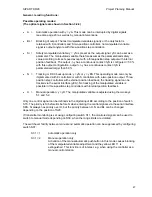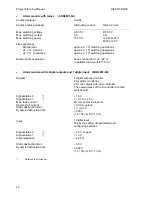
SIPART DR20
Project Planning Manual
In section y = 0 % to ya (
cooling
)
the period is set using T- and the associated output is -
∆
y. The control ratio is then from 1
at y = 0 % at y = ya.
In section y = ye to 100 % (
heating
)
the period is set using T+ and the associated output is +
∆
y. The control ratio is then from 0
at y = ye to 1 at y = 100 %
If only one output range is required with a normal-action system (e.g. heating),
∆
y
should
be used and ya and ye both set to 0 % (Fig. 3/27b).
With a reverse-action system (e.g. cooling), output -
∆
y
should be used and ya and ye both set to
100 %.
ON
ON
switch-on
duration
switch-off
duration
OFF
Output +
∆
y
Output -
∆
y
Period T +
Period T -
switch-on
duration
switch-off
duration
t
Parameter T +
≅
Ty
Fig. 3/26
Switch-on duration, switch-off duration, period
The period (T+ and T-) is adjustable. The switch-on and switch-off durations are then longer or
shorter accordingly. The ratio between these two is not changed. This only depends on the
negative deviation and the control algorithm.
1
0
1
0
Control ratio
Control ratio
Output
-
∆
y
Output
+
∆
y
y
a
y
e
0 %
100 %
y
y
0 %
100 %
Output
+
∆
y
y
a
= y
e
= 0 %
a)
b)
Fig. 3/27
Response of manipulated variable with two-position controller
a) with 2 output channels,
b) with 1 output channel
53






























